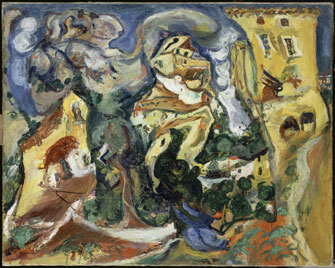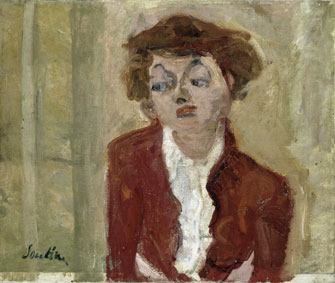The Method in Soutine’s
Expressionist Madness

Soutine’s “Le Village” (1923). © ADAGP, Paris 2012 © RMN (Musée de l’Orangerie)/Hervé Lewandowski
Some of the paintings by Chaïm Soutine (1893-1943) on show at Paris’s Musée de l’Orangerie look as if they were painted by an out-of-control madman (see “Le Village” above, for example), but – as the title of the exhibition, “Order out of Chaos” – implies, there was method in the madness of the man who was one of the few Expressionist painters working in France.
This show, unlike the one held at the Pinacothèque de Paris several years ago, plays down Soutine’s psychology, mentioned here only in a video in which the artist’s friend, collector and patroness, Madeleine Castaing, talks about his exacting standards, impassioned approach to painting and occasional tendency to destroy his paintings by slashing and burning them.
Born to a Jewish family near Minsk, in today’s Belarus, Soutine ended up as a star of the Montparnasse artistic scene. The torment we see in many of his works – especially those he painted in Céret, in the South of France, where he had been sent by his dealer, Léopold Zborowski, to work between 1919 and ’22 – calmed greatly once success came his way and his paintings began to sell to such collectors as Paul Guillaume (whose 22 works, which now belong to the Musée de l’Orangerie, form the nucleus of this show of 70 paintings) and the American Albert Barnes, who in 1922 bought dozens of works by Soutine in one fell swoop.
The exhibition takes us through each of the genres Soutine worked in, all of which he excelled at. Among the wilder landscapes, in which the buildings and trees seem to be severely rattled by earthquakes or caught up in whirlwinds that will soon rip them from the face of the earth, is “La Route La Route Folle à Cagnes, la Gaude” (1923), in which the road looks as if it has been peeled off the earth and lifted into the sky, taking the houses and trees along with it. In “Paysage” (1922-23), you can almost feel the Mistral blowing fiercely against the landscape and bending it out of shape while the hot sun beats down on it.
The portraits show his surprising sensitivity in bringing out the personalities of his subjects even while distorting their appearance. In her portrait, for example, Castaing looks sophisticated and worldly yet not entirely at ease as she twists her fingers nervously in her lap. And look at the marvelous insouciance of “Jeune Anglaise” (c. 1934), a redhead in a red jacket with red lips (the day I visited the show,

Soutine’s “Jeune Anglaise” (1934). © ADAGP, Paris 2012 © RMN (Musée de l’Orangerie)/Hervé Lewandowskia young redheaded woman in a red jacket who could easily have been the model was wandering through the exhibition – planted there by the museum?).
Many of the still lifes were inspired by the masters Soutine admired and take up subjects they treated in their work: Rembrandt’s animal carcasses, for example, or Chardin’s bloody gutted skate, which in Soutine’s version (“Nature Morte à la Raie,” 1923) has a leering, clown-like, almost human expression on its face.
One of the simplest works in the exhibition is also one of my favorites: the “Nature Morte aux Harengs” (c. 1916), in which the three gaping, staring silver herrings look as if they are imprisoned by the claws of the two forks resting on each side of the plate.
Soutine was a brilliant colorist, and while there are many stunning color combinations in the show, the one you will take away with you is red – the intense, violent, bloody carmine red of the skirts of his choirboys, Madeleine Castaing’s dress, the animal carcasses, the vases full of gladioli, a staircase running like a gash through a peaceful village, the handkerchief clutched in the hands of “Le Petit Pâtissier” (1922-23), shocking against his white clothing, and so on.
He was also a true original, influenced by his predecessors and an influence on later artists (Francis Bacon, for example), but unlike any of them.
Musée de l’Orangerie: Jardin des Tuileries, 75001 Paris. Métro: Concorde. Tel.: 01 44 77 80 07. Open Wednesday-Monday, 9am-6pm. Admission: €7.50. Through January 21, 2013. www.musee-orangerie.fr
Reader reaction: Click here to respond to this article (your response may be published on this page and is subject to editing).
Please support Paris Update by ordering books from Paris Update’s Amazon store at no extra cost. Click on your preferred Amazon location: U.K., France, U.S.
More reviews of Paris art shows.
© 2012 Paris Update
